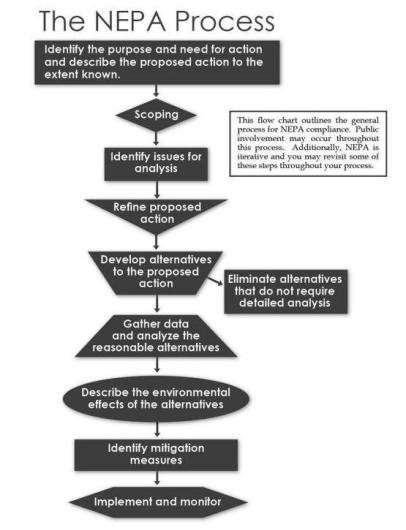
National Environmental Policy Act (NEPA) 101
Have you heard of the National Environmental Policy Act (NEPA)? Do you know how NEPA informs land management decisions? Do you know how can you be involved in the land management decision processes?
National Environmental Policy Act
The National Environmental Policy Act became law in 1970. This legislation established a landmark national environmental policy which, among other things, encourages environmental protection and informed decision-making. It provides the means to carry out these goals by:
- Mandating that every Federal agency prepare a detailed statement of the effects of “major Federal actions significantly affecting the quality of the human environment.”
- Establishing the need for agencies to consider alternatives to those actions.
- Requiring the use of an interdisciplinary process in developing alternatives and analyzing environmental effects.
- Requiring that each agency obtain comments of any Federal agency which has jurisdiction by law or special expertise with respect to any environmental impact involved.
- Requiring that detailed statements and the comments and views of the appropriate Federal, State, tribal, and local agencies be made available to the public.
- Providing opportunities for the public to comment on the environmental analyses that guide federal decision making.
NEPA is essential in helping BLM meets its responsibility to America. Congress, through the Federal Land Policy Management Act, tasked BLM with the mission to sustain the health, diversity, and productivity of public lands for the use and enjoyment of present and future generations under a multiple use/sustained yield framework. NEPA, which was crafted in part to “encourage productive and enjoyable harmony between man and his environment,” factors into almost every decision BLM makes with respect to land use. Its analytical framework brings together ecological, social, and economic science in a meaningful way to inform BLM on the best path forward to meet the needs of today without compromising the ability of future generations to meet their needs.
What is the NEPA process?
The NEPA process guides Federal actions and decisions with respect to the environment. In the BLM, these decisions typically arise out of proposed projects that affect public land. Proposals can originate from within the BLM or submitted to the BLM by other entities.
NEPA Process
This flow chart outlines the general process for NEPA compliance. Public involvement may occur throughout this process. Additionally, NEPA is iterative and you may revisit some of these steps throughout your process.
- Identify the purpose and need for action and describe the proposed action to the extent known.
- Scoping
- Identify issues for analysis
- Refine proposed action
- Develop alternatives to the proposed action.
- Eliminate alternatives that do not require detailed analysis.
- Gather data and analyze the reasonable alternatives
- Describe the environmental effects of the alternatives
- Identify mitigation measures
- Implement and monitor
ePlanning
ePlanning is the online BLM National NEPA and Land Use Planning Register. The National NEPA Register allows online review and comment, if applicable, of projects and land use plans under BLM consideration. The site is organized and user-friendly. Visitors can search for projects by geographic location, project resource type, project year and other specific fields.
Scoping
Scoping is the part of the NEPA process by which the BLM solicits internal and external input on the issues, impacts, and potential alternatives that will be addressed in an assessment as well as the extent to which those issues and impacts will be analyzed in the NEPA document. It is typically the first opportunity for the public to get involved in NEPA.
Public Involvement
NEPA regulations require that agencies “make diligent efforts to involve the public in preparing and implementing NEPA procedures.” BLM uses a wide variety of ways to engage the public in the NEPA process including scoping, consulting with tribes, individuals, organizations and agencies.
The primary goal of public involvement is to ensure that all interested and affected parties are aware of the proposed action. Public meetings, open houses or field trips may accompany scoping. Notifications methods include social media, website information, newsletters, Federal Register Notices, bulletin boards, and newspapers.
Public Comments
Your comments matter! BLM wants members of the public to contribute their expertise and insights to NEPA analyses. However, NEPA is a structured framework that only allows for consideration of substantive comments on draft Environmental Analyses and Environmental Impact Statements. If you plan on submitting a comment, use the following guidelines so your comment is considered substantive and is carefully considered:
- Questions the accuracy of information in the EIS or EA.
- Questions the adequacy of, methodology for, or assumptions used for the environmental analysis.
- Presents new information relevant to the analysis.
- Presents reasonable alternatives other than those analyzed in the EIS or EA.
- Provides information which would cause changes or revisions in one or more of the alternatives.
While non-substantive comments may be received and acknowledged, the NEPA process is not the best venue to express general support or opposition to a proposal. Comments that are not considered substantive include the following.
- Comments in favor of or against the proposed action or alternatives without reasoning that meet the criteria listed above (such as “we disagree with Alternative Two and believe the BLM should select Alternative Three”).
- Comments that only agree or disagree with BLM policy or resource decisions without justification or supporting data that meet the criteria listed above (such as “more grazing should be permitted”).
- Comments that don’t pertain to the project area or the project (such as “the government should eliminate all dams,” when the project is about a grazing permit).
- Comments that take the form of vague, open-ended questions.
- Comments directed at the Administration or President of the United States.
- Examples of Substantive Comments
-
"BLM's analysis of local groundwater quantity is insufficient. A 2016 study from the University [source and citation] offers a more complete understanding of drought impacts to the aquifer in question, and should be incorporated into the environmental analysis to better inform the decision with regards to the proposed rangeland well's water resource impacts."
"BLM's assessment of the affected environment for recreation is incorrect. The southern slopes of this area are popular areas for bouldering, bird watching, and backcountry camping. This is not recognized. In each alternative, the proposed mining project would limit access to these places and create noise and visual impacts which would degrade the experience of recreation. BLM should correct this analytical omission."
- Examples of Non-substantive Comments
-
"This project should be denied. It's just another attempt by the agency to give away the public lands that local communities depend on for their livelihoods.“
"BLM should not authorize the new mountain bike trails. No matter what the so-called analysis says, I know mountain bikers are bad for the environment and don't help the economy."
- NEPA Resources

